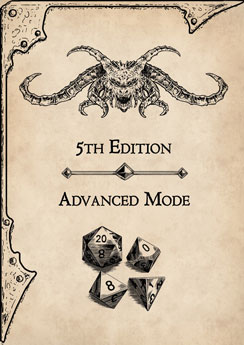Medium beast (giant animal), unaligned
Armor Class 15 (Natural Armor)
Hit Points 19 (3d8 +6)
Speed 40 ft., burrow 5 ft.
Proficiency Bonus +2
Proficiency Bonus +2 (5th Edition Advanced Mode)
| STR | DEX | CON | INT | WIS | CHA |
|---|---|---|---|---|---|
| 16 (+3) | 12 (+1) | 14 (+2) | 1 (-5) | 9 (-1) | 2 (-5) |
Skills Perception +1
Weaknesses Cold, Fire
Senses tremorsense 60 ft., passive Perception 9
Languages Pherormones
Challenge 1/4 (50 XP)
ACTIONS
- Multiattack. The giant warrior ant makes one attacks with its bite. If the bite hits the target, then the giant ant warrior can make an additional attack with the sting on the same target.
- Bite*. Melee Weapon Attack: +5 to hit, reach 5 ft., one target. Hit: 7 (1d8 + 3) piercing damage. The target must make a DC 12 Dexterity saving throw, taking 10 (3d4) acid damage on a failed save, or half as much damage on a successful one.
- Sting*. Melee Weapon Attack: +5 to hit, reach 5 ft., one creature. Hit: 2 (1d4) piercing damage. The target must make a DC 12 Constitution saving throw, taking 10 (3d4) poison damage on a failed save, or half as much damage on a successful one.
- *Note: A giant ant warrior may possess the acidic bite or the poisonous sting, but not both, depending on the giant ant species it belongs to.
5th Edition Advanced Mode
Limiting the power of a character and making the overall difficulty of the game harder, does not reduce the creativity, indeed it does quite the opposite.
The Game Master has the option to use any and all of the instances proposed in this guide, or just some of them according to their preference.
It is the lack of something that move and motivate characters, not the abundance of it
DESCRIPTION
Giant ant warriors are a type of giant ant, but much bigger than normal ants. They have a reddish-brown exoskeleton, six legs, two antennae, and a pair of mandibles. They are about 10 feet long and weigh about 800 pounds. They have a stinger at the end of their abdomen that can inject venom into their enemies. Giant ant warriors are loyal to their colony and will defend it with their lives. They are usually found in the company of other giant ants, such as workers, soldiers, drones, and the queen.
COMBAT
Giant ant warriors are fierce fighters that use their mandibles and stinger to attack their foes. They can also spray a stream of acid from their mouth that can burn through flesh and metal. They have a keen sense of smell and can track their prey by following their scent. They communicate with other giant ants through the use of complex pheromones that convey information such as danger, food, or location.
Giant ant warriors are vulnerable to fire and cold, which can damage their exoskeleton and slow them down. They are also susceptible to sonic attacks that can disrupt their pheromone communication. They have a low intelligence and will follow the orders of their queen or the most dominant giant ant in their group. They will fight to the death unless they are outnumbered or outmatched.
HABITAT/ ECOLOGY
Giant ant warriors live in underground colonies that can span miles in diameter. They dig tunnels and chambers with their mandibles and secrete a substance that hardens the walls. They have a strict social hierarchy that is based on their roles and functions. The queen is the leader and the mother of all giant ants in the colony. She lays thousands of eggs that hatch into workers, warriors, soldiers, or drones. The workers are responsible for gathering food, maintaining the colony, and caring for the eggs and larvae. The warriors are the main defenders of the colony and will patrol the perimeter and attack any intruders. The soldiers are larger and stronger than the warriors and will guard the queen and her chamber. The drones are the males that mate with the queen once in their lifetime and then die.
Giant ant colonies are usually isolated from each other and will compete for resources and territory. Sometimes, they will form alliances with other colonies or creatures that can benefit them, such as giant spiders, beetles, or scorpions. They will also raid nearby settlements or caravans for food or treasure. Giant ants are omnivorous and will eat anything they can find, including plants, animals, or even metal.
ECOLOGY
Giant ant warriors play an important role in their ecosystem as predators and scavengers. They help control the population of other creatures that might pose a threat to their colony or their environment. They also recycle organic matter and minerals by consuming them and returning them to the soil through their waste products.
Giant ant warriors are valued by some adventurers, hunters, or collectors for their body parts or products. Their exoskeletons can be used to make armor or shields that are resistant to acid or piercing damage. Their venom can be extracted and used to make poisons or potions that can paralyze or harm their enemies. Their acid glands can be used to make weapons or tools that can melt through obstacles or locks. Their pheromones can be used to make perfumes or oils that can attract or repel other creatures.
